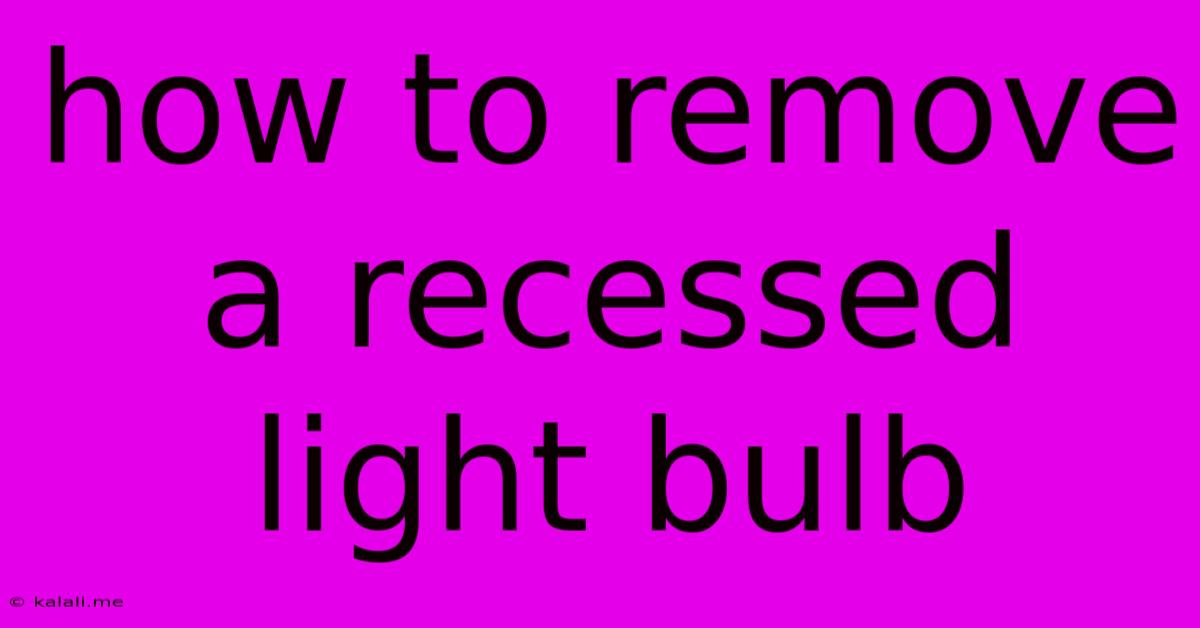How To Remove A Recessed Light Bulb
Kalali
Jun 08, 2025 · 3 min read

Table of Contents
How to Remove a Recessed Light Bulb: A Step-by-Step Guide
Changing a recessed light bulb might seem daunting, but with the right approach and safety precautions, it's a manageable task for most homeowners. This guide provides a comprehensive walkthrough, covering various types of recessed lights and addressing common challenges. This article will cover everything from identifying your fixture type to safely replacing the bulb, ensuring a quick and successful outcome.
Understanding Recessed Lighting Fixtures
Recessed lighting, also known as downlights, is a popular choice for its sleek design and efficient illumination. However, accessing the bulbs within these fixtures can vary significantly. Before you begin, it's crucial to identify the type of recessed light fixture you have. There are generally two main types:
- Screw-in Bulbs (Most Common): These fixtures use standard screw-in bulbs, making them the easiest to replace. Common bulb types include BR30, PAR30, and GU10.
- Pin-based Bulbs (Less Common): These fixtures utilize bulbs with pins instead of a screw base. These typically require a bit more care and sometimes special tools for removal.
Safety First: Essential Precautions
Before you even think about touching a light bulb, prioritize safety:
- Turn Off the Power: This is the most crucial step. Locate the circuit breaker that controls the recessed lighting circuit and switch it OFF. Double-check that the power is off by using a non-contact voltage tester.
- Let the Bulb Cool: Always allow the bulb to cool completely before attempting to remove it. A hot bulb can cause burns.
- Use Appropriate Tools: Depending on your fixture, you might need a simple ladder, a screwdriver, or even needle-nose pliers.
Step-by-Step Guide to Removing a Recessed Light Bulb
1. Accessing the Bulb:
- Screw-in Bulbs: Simply twist the bulb counter-clockwise to unscrew it. If it's stuck, try gently wiggling it back and forth while turning.
- Pin-based Bulbs: These often require a gentle twist and pull. Sometimes, a slight pressure on the sides might be needed to release the bulb from its socket. If it's particularly stubborn, you may need to consult your fixture's instructions or look for online videos showing how to remove this specific type.
2. Removing the Old Bulb:
Once the bulb is loose, carefully remove it from the socket. Avoid applying excessive force, as this can damage the fixture or the bulb.
3. Installing the New Bulb:
- Screw-in Bulbs: Carefully insert the new bulb into the socket and turn it clockwise until it's secure.
- Pin-based Bulbs: Align the pins on the new bulb with the corresponding slots in the socket and gently push it in until it clicks into place.
4. Testing the New Bulb:
Once the new bulb is installed, switch the power back on at the circuit breaker. Check to make sure the new bulb is working correctly.
Troubleshooting Common Problems
- Bulb Stuck: If the bulb is stuck, try using a rubber grip or pliers with rubber grips to provide a better grip. Avoid applying excessive force.
- Damaged Socket: If the socket is damaged or the bulb won't fit properly, you might need to replace the entire fixture. This is best left to a qualified electrician.
- Flickering Bulb: If the bulb flickers after installation, there could be a problem with the wiring or the circuit breaker. Again, consulting an electrician is recommended.
Choosing the Right Replacement Bulb
Remember to replace the bulb with one that's compatible with your fixture. Check the existing bulb for wattage and type (e.g., BR30, PAR30, GU10). Using an incorrect bulb can damage the fixture or cause safety hazards. Consider energy-efficient options like LEDs for long-term cost savings and reduced energy consumption.
By following these steps and prioritizing safety, you can confidently replace your recessed light bulb. However, if you encounter significant difficulties or are unsure about any part of the process, it's always best to consult a qualified electrician. They can safely diagnose and address any complex issues.
Latest Posts
Latest Posts
-
How Long Can Wet Food Sit Out
Jun 08, 2025
-
How To Read The Http Traffic Of Usb Tethering
Jun 08, 2025
-
21 Degree Vs 30 Degree Framing Nailer
Jun 08, 2025
-
Does A Gas Dryer Have A Pilot Light
Jun 08, 2025
-
Who Is The Elect Lady In 2 John
Jun 08, 2025
Related Post
Thank you for visiting our website which covers about How To Remove A Recessed Light Bulb . We hope the information provided has been useful to you. Feel free to contact us if you have any questions or need further assistance. See you next time and don't miss to bookmark.